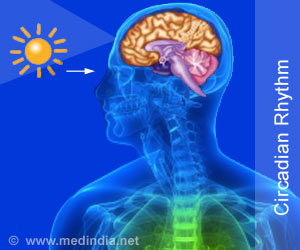.
‘A single blood test can assess the timing of circadian rhythm based on different levels of metabolites.’
“If we can understand each individual person’s circadian clock, we can potentially prescribe the optimal time of day for them to be eating or exercising or taking medication,” said senior author Christopher Depner, who conducted the study while an assistant professor of integrative physiology at CU Boulder.
A brain region called the hypothalamus helps to regulate the body’s 24-hour cycle, including when people naturally feel sleepy at night and have the urge to wake up in the morning.
Recent studies have revealed that nearly every tissue or organ in the body also has an internal timing device, which is synced with hypothalamus and dictates to secrete certain hormones, heart and lungs function throughout the day, the tempo of our metabolism and more.
Drug targeting 82% of protein-coding genes show 24-hour time-of-day patterns, also suggest that many medications can work better and yield fewer side effects if administration is timed appropriately.
Even in healthy people sleep-wake cycles can vary by four to six hours. Simply asking someone whether you are a morning lark or a night owl can provide hint to a person’s circadian cycle.
But the only way to precisely gauge the timing of an individual’s circadian clock is to perform a dim-light melatonin assessment, which involves keeping the person in dim light and drawing blood or saliva hourly for up to 24 hours to measure melatonin.
Melatonin is a hormone that naturally increases in the body to signal bedtime and wanes to help wake us up.
In pursuit of a more precise and practical test, researchers brought 16 volunteers to live in a sleep lab for 14 days under tightly controlled conditions.
In addition to testing their blood for melatonin hourly, they also used a method called “metabolomics”, assessing levels of about 4,000 different metabolites (things like amino acids, vitamins and fatty acids that are by-products of metabolism) in the blood.
They used a machine learning algorithm to determine which collection of metabolites were associated with the circadian clock by creating a sort of molecular fingerprint for individual circadian phases.
Circadian phase predicted based on this fingerprint from a single blood draw were within about one hour of the more arduous melatonin test.
The test was significantly more accurate when people were well rested and had not eaten recently – a requirement that could make the test challenging outside of a laboratory setting.
To make it more feasible and affordable, a commercial test would likely have to narrow down the number of metabolites it’s looking for (their test narrowed it down to 65).
Other research, including some from Wright’s lab, is exploring proteomics (looking for proteins in blood) or transcriptomics (measuring the presence of ribonucleic acid, or RNA) are taking place to assess circadian phase.
The researchers hope one day people can do a blood test to precisely determine their circadian phase, so that doctors can prescribe accordingly.
Source: Medindia



